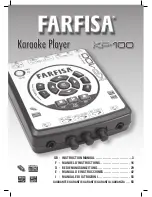
MAINTENANCE
5 EN
EN
N. B.:
the power source is fitted with an anti-sticking device that
disables power if output short circuiting occurs or if the electrode
sticks, allowing it to be easily detached from the workpiece. This
device enters into operation when power is supplied to the gener-
ator, even during the initial checking period, therefore any load in-
put or short circuit that occurs during this phase is treated as a
fault and will cause the output power to be disabled.
4.0
MAINTENANCE
IMPORTANT: DISCONNECT THE POWER PLUG AND WAIT
AT LEAST 5 MINUTES BEFORE CARRYING OUT ANY MAIN-
TENANCE. MAINTENANCE MUST BE CARRIED OUT MORE
FREQUENTLY IN HEAVY OPERATING CONDITIONS.
Carry out the following operations every three (3) months:
a. Replace any illegible labels.
b. Clean and tighten the welding terminals.
c. Repair or replace damaged welding cables.
d. Have specialized personnel replace the power cable if
damaged.
Carry out the following operations every six (6) months:
Remove any dust inside the generator using a jet of dry air.
Carry out this operation more frequently when working in very
dusty places.
5.0
TYPES OF MALFUNCTIONING / WELDING
FAULTS – CAUSES – REMEDIES
TYPES OF MALFUNCTIONING
WELDING FAULTS
POSSIBLE CAUSES
CONTROLS AND REMEDIES
The generator does not weld.
A) The main switch is off.
B) The power lead is interrupted (lack of one or
two phases).
C) Other.
A) Switch on mains.
B) Verify and repair.
C) Ask for the intervention of the Assistance Centre.
During welding suddenly the outgoing current is
interrupted, the green led is off and the yellow
led goes on.
Overheating has occurred and the automatic pro-
tection has come on. (See work cycles).
Keep generator switched on and wait till temperature
has dropped again (10-15 minutes) to the point where
the yellow switch goes off again.
Welding power reduced.
Outgoing wires are not correctly attached.
A phase is missing.
Check that wires are intact, that the pliers are suffi-
cient and that they are applied to welding surface
clean from rust, paint or oils.
Excessive jets.
Welding arch too long.
Welding current too high.
Wrong torch polarity, lower the current values.
Craters.
Fast removal of the electrodes.
Inclusions.
Inadequate cleaning and bad distribution of coating.
Faulty movement of the electrodes.
Inadequate penetration.
Forward speed too high. Welding current too low.
Sticking.
Welding arch too short.
Current too low.
Increase current values.
Blowing and porosity.
Damp electrodes. Arch too long. Wrong torch polarity.
Jacks.
Currents too high. Dirty materials.
The electrode fuses in TIG.
Wrong torch polarity. Type of gas not suitable.







































